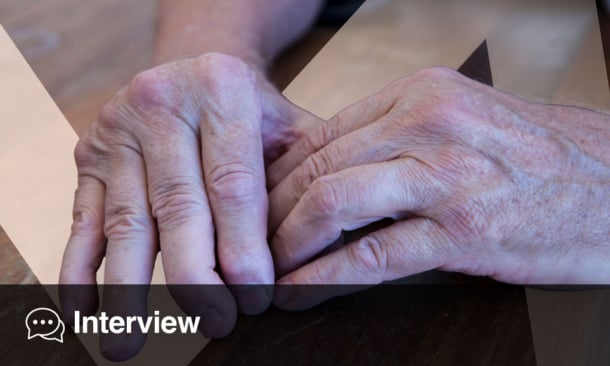THE EUROPEAN Alliance of Associations for Rheumatology (EULAR) 2025 Congress, the most dynamic event of the year for the rheumatology community, took place in the vibrant city of Barcelona, Spain, between the 11th–14th of June. A city known for its dynamic spirit, architectural innovation, and rich cultural heritage, Barcelona provided the ideal backdrop for a congress focused on progress, collaboration, and patient-centred care.
The Welcome Ceremony set the tone for an inspiring and ambitious meeting with the EULAR President, Daniel Aletaha, making a memorable entrance on a scooter, symbolising the forward momentum of both the organisation and the specialty. In his address, Aletaha reflected on the challenges of misinformation in today’s world, remarking: “Maybe we cannot change the world, but as those caring for people with [rheumatic and musculoskeletal diseases], we can at least make sure that our patients trust us.” He emphasised EULAR’s responsibility to remain a trusted, evidence-based source for clinicians, healthcare professionals, and patients alike.
The ceremony continued with an exciting announcement of the launch of MyEULAR, a new digital membership platform designed to unite the community, enhance education, and foster greater engagement. Other highlights included the strengthening of the RheumaFacts initiative, which is aimed at supporting data-driven advocacy and policy-making, and the recognition of outstanding contributions through abstract and achievement awards. The Congress also celebrated the growth of EULAR’s Centers of Excellence network, now comprising 40 institutions across Europe, and the launch of new initiatives to promote equity, global collaboration, and innovative rheumatology education.
A moment of pride accompanied the recognition of exceptional contributions through EULAR’s abstract and achievement awards, which honour excellence across basic science, clinical research, healthcare professional innovation, patient research, and medical education. The ceremony also welcomed new additions to EULAR’s Centers of Excellence, further expanding the network and strengthening its role in shaping future generations of rheumatology researchers and clinicians.
Delegates were encouraged to take full advantage of a packed programme, including dynamic formats such as fishbowl discussions on health policy, gaslighting, and unconscious bias, alongside cutting-edge scientific sessions. In his concluding remarks, Aletaha reflected on his final year as the Congress President and encouraged delegates to embody EULAR’s mission “to advance science, empower patients, and strengthen the global rheumatology community.”
EMJ was thrilled to be a part of the 2025 Congress and look forward to attending the EULAR 2026 Congress, which will be held in London, UK.
Should Standard Care for Rheumatic and Musculoskeletal Diseases Include Physical Activity?
MULTIPLE sessions at the EULAR 2025 Congress put the spotlight on the barriers to and benefits of physical activity for people with rheumatic and musculoskeletal diseases (RMD).1-6
New research presented at the event assessed the long-term effects on physical function and quality of life that implementing personalised, supervised exercise therapy for patients with rheumatoid arthritis (RA) or axial spondyloarthritis (axSpA) has.1 Participants in the study received 64 planned exercise sessions (plus an additional 14, if required) during Year 1, and in Year 2, continuation and the number of sessions (for up to 42 months) were determined by the patient and physiotherapist. They found that at 2 years, except for the mental component score of the 36-Item Short Form Survey (SF-36), there were statistically significant improvements across all other outcome measures, indicating that long-term, personalised, and supervised exercise is beneficial for function and quality of life. This was found to be sustained, irrespective of decline in use during the second year of the study.
Other researchers presented findings on the efficacy and cost-utility of a multimodal, physiotherapist-led, vocational or work-oriented intervention on work-related outcomes, compared to usual care, for patients with axSpA and RA.2 They recruited 140 adult patients with reduced work ability to participate in 10–21 sessions. These included mandatory modalities such as exercise therapy, patient education, referral-roadmaps of work-related professionals, and work-oriented assessments, alongside optional modalities (workplace examination or self-management courses), over a 12-month period. Excluding work-related outcomes, intervention was found to be superior regarding quality-adjusted life years, and cost-effective when compared to usual care.
The symptom of fatigue is important to manage in patients with RMD, and physical activity has been reported to positively impact fatigue levels. To explore whether physical activity patterns (stepping time and intensity) and sedentary behaviour influence multi-dimensional aspects of fatigue, researchers examined data from 104 patients with RA.3 The results revealed that sitting time was significantly higher in the evening, and that the time and intensity of physical activity in the morning and afternoon were similar. Time and physical activity intensity were significantly negatively related to general and physical fatigue, as well as reduced motivation and activity. Evening physical activity was positively associated with general and physical fatigue. This research highlights the importance of considering diurnal physical activity patterns when designing interventions for fatigue management.
Exploring the impact of exercise programmes that include aerobic and resistance training in systemic sclerosis (SSc), researchers from the LENI research group, Sheffield Hallam University, UK, presented findings from a multicentre, randomised clinical trial involving 170 individuals with SSc.4 In addition to usual care, for 12 weeks, those randomised to the exercise group participated in a twice-weekly supervised programme. This included high-intensity interval training and resistance training. Compared to the control group, pain and fatigue had significantly improved at 12 weeks. Additionally, benefits were also seen for cardiorespiratory and musculoskeletal fitness, depression, and quality of life. Those in the control group experienced a slight worsening across these metrics, indicative of a protective effect from exercise. The authors concluded that exercise could form an effective, non-pharmacological intervention in SSc.
Whilst the benefits of exercise were made clear across these presentations, two key studies reflected on the barriers faced when implementing exercise into standard care. One such qualitative study, conducted in the Netherlands, explored barriers and facilitators to long-term, personalised exercise therapy for individuals with axSpA and RA.5 Patients, healthcare professionals, and insurers completed 18 semi-structured interviews, noting unclear eligibility criteria, limited knowledge on exercise effectiveness, lack of awareness on where to find qualified therapists, and consultation time constraints as key barriers. However, they highlighted strong communication between healthcare professionals and patients, clear explanations of benefits, clear eligibility criteria, and addressing concerns about exercise as key facilitators.
Another study to identify barriers to physical activity included 602 patients with RA, axSpA, or osteoarthritis who completed a survey.6 This identified that the median duration of exercise was 60 minutes per week, which is less than half of what is recommended by EULAR. The survey also revealed that weather conditions, membership costs, and work-related duties were the top barriers to exercise, and that scheduled exercises, healthcare professional support, having the knowledge and fitness to exercise, and shorter travel to facilities were the top facilitators. There were significant differences across the countries included (France, Switzerland, the Netherlands, and Türkiye), suggesting a need for interventions tailored to specific countries to help break down the barriers.
Overall, these studies emphasise the benefit of exercise for patients with RMD and suggest that several challenges need to be addressed to help break down barriers to improve accessibility, ultimately ensuring that exercise becomes a part of standard care.
Early Biologics and Combination Therapy in Psoriatic Arthritis: Insights from the SPEED Trial
NEW data presented at the EULAR 2025 Congress showcased the latest findings on early intervention strategies in psoriatic arthritis (PsA) in patients with poor prognostic factors.7 The SPEED trial, funded by the UK’s National Institute for Health Research (NIHR), aimed to determine whether early biologic therapy offers superior disease control compared to conventional approaches.
In this randomised trial of 192 patients with PsA who have poor prognosis, participants received one of three regimens: standard step-up treatment with conventional synthetic disease-modifying antirheumatic drugs (csDMARDs), combination csDMARDs, or early induction with a TNF inhibitor (TNFi). The primary outcome was mean Psoriatic Arthritis Disease Activity Score (PASDAS) at 24 weeks. Results showed that both early TNFi and combination csDMARD therapy provided better disease control at 24 weeks compared to standard care. However, by 48 weeks, only the early TNFi group sustained significant benefit over standard step-up care. Notably, early TNFi and combination csDMARDs showed comparable efficacy at the 24-week mark. Lead investigator Laura Coates, University of Oxford, UK, emphasised that initial intensive therapy, whether biologic or combination csDMARD, delivers more rapid disease control, with early TNFi offering sustained benefit at 1 year even after just 6 months of biologic therapy.
These findings highlight the potential of early intensive treatment strategies in PsA and suggest that combination biologic disease-modifying antirheumatic drug and targeted synthetic disease-modifying antirheumatic drug regimens may offer a viable option for refractory disease. However, the authors stress the need for longer-term and randomised studies to confirm these promising results and fully assess safety.
Early Red Flags Predict Systemic Sclerosis Progression
OVER half of patients with early signs of systemic sclerosis (SSc) experience clinically significant disease progression within 5 years, according to new data presented at the EULAR 2025 Congress.8
The study focused on individuals with Raynaud’s phenomenon and one or more Very Early Diagnosis of Systemic Sclerosis (VEDOSS) red flags, including puffy fingers, SSc-specific autoantibodies, or nailfold capillary abnormalities, but who did not yet meet the 2013 American College of Rheumatology (ACR)/EULAR classification criteria or have signs of fibrosis. Patients were tracked to identify when they first developed a meaningful clinical event such as skin fibrosis, digital ulcers, or lung involvement. Researchers used time-to-event analysis to examine the pace of disease evolution and identify key predictive markers.
Among 442 patients studied (90% female; median age: 45 years), 51.1% experienced at least one significant clinical event over a median of 26 months’ follow-up. The cumulative probability of SSc progression rose from 11.1% at 1 year to 65.6% at 5 years. The most common first events included skin thickening with a modified Rodnan skin score of ≥1 (31.5%), reduced lung diffusion capacity (29.8%), and digital ulcers or gangrene (15.1%). Importantly, 62.4% of patients developed these events before meeting the official ACR/EULAR classification threshold, suggesting that waiting for criteria fulfilment may delay intervention. Univariate Cox regression analysis found that older age, anti-topoisomerase or anti-centromere antibodies, oesophageal symptoms, and giant capillaries significantly predicted progression, with hazard ratios ranging from 1.66–3.70.
These findings reinforce the clinical value of the VEDOSS criteria in identifying SSc early, before irreversible damage occurs. Proactive identification and early treatment could dramatically reduce long-term morbidity in patients at risk.
Updated Evidence on Cancer and Cardiovascular Risks of JAK Inhibitors in Rheumatoid Arthritis
NEW findings presented at the EULAR 2025 Congress offer updated insights into the safety profile of JAK inhibitors (JAKi) in rheumatoid arthritis (RA), particularly regarding cancer and cardiovascular risks.9
Following earlier concerns raised by the ORAL Surveillance trial, which linked tofacitinib to a higher cancer risk compared to TNF inhibitors (TNFi), regulatory bodies issued cautionary guidance. However, real-world evidence has remained limited.
A large, multinational, registry-based study examined 53,169 treatment initiations in 33,127 patients with RA. A total of 219 non-melanoma skin cancers (NMSC) and 638 non-NMSC cancers were reported. While crude cancer rates were slightly higher in patients on JAKis compared to TNFis, adjusted analyses found no significant differences in the incidence of NMSCs or other cancers between JAKis and either TNFis or other biologic disease-modifying antirheumatic drugs (other modes of action), including in high-risk subgroups aged 50+ years with cardiovascular risk factors.
Additional data from the Swedish Rheumatology Quality Register (SRQ) found a higher risk of keratinocyte cancers, especially basal cell carcinoma, in patients treated with JAKis, including a greater chance of a second diagnosis in those with a prior history. The findings suggest routine skin checks may be warranted for this population.
Separately, a retrospective study suggested that glucagon-like peptide-1 (GLP-1) receptor agonists may reduce the risk of certain cardiovascular events in patients with RA who are on JAKis. Those who initiated GLP-1 receptor agonists had lower rates of acute coronary syndromes and deep vein thrombosis. While promising, these findings need further validation. Overall, the new data are cautiously reassuring, but highlight the importance of ongoing and personalised risk assessments.
Lower Income Linked to Worse Lupus Prognosis
A NATIONWIDE Swedish study, presented at the EULAR 2025 Congress, has revealed a strong association between social determinants of health and long-term outcomes in individuals newly diagnosed with systemic lupus erythematosus (SLE).10
SLE is a complex autoimmune condition marked by significant variability in symptoms and progression, often resulting in organ damage and increased mortality. While disparities in SLE outcomes have been linked to socioeconomic and social factors, this study is one of the first in Europe to explore these relationships in a national population-based cohort with access to universal healthcare.
The study included 2,434 adults diagnosed with SLE between 2005–2021. Data were drawn from Swedish health and administrative registries, and variables such as income, education, marital status, work ability, employment, and immigration status were assessed at the time of diagnosis. Outcomes of interest included the development of organ damage and mortality, monitored from 1-year post-diagnosis through to 2022.
The findings showed that individuals with lower income (under 171,000 SEK annually) or limited education (9 years or less) faced a 30–40% higher risk of early organ damage than those in higher socioeconomic categories. Similarly, individuals who were divorced or widowed, or had a history of sick leave or disability, were at significantly higher risk of both damage and death. Single, separated, or widowed individuals had an elevated mortality risk, while those with a history of sick leave or disability benefits experienced a 78% higher risk of death. Interestingly, being born outside Sweden was not associated with worse outcomes, suggesting that immigration status may not be a key factor in SLE prognosis within systems offering universal healthcare.
This research highlights the importance of considering social determinants of health when managing SLE. Targeted interventions aimed at improving access to care, health literacy, and social support may help to address these disparities and ultimately improve health outcomes for patients living with SLE.
Are Osteoarthritis Clinical Practice Guidelines Being Followed in the Real World?
ILLUMINATING findings from the BLOAR registry were presented at the EULAR 2025 Congress.11
EULAR has developed specific recommendations and clinical practice guidelines for managing knee, hip, and hand osteoarthritis (OA); however, knowledge surrounding guideline adherence in the real world is scarce. To address this, researchers analysed data from 1,716 Austrian patients with OA who were treated in everyday clinical practice in the BLOAR registry. Of those included, 52.2%, 23.5%, 17.7%, and 6.7% were receiving treatment for OA of the knee, hand, hip, and other joints, respectively. Pain averaged 24.7 at rest and 42.8 during activity, based on a scale of 1–100, and >80% of participants were either moderately or severely affected by their OA.
The study authors found that 67.0% of patients reported having consultations and visits with physicians, 61.4% reported having received physiotherapy with a licensed physiotherapist, and 60.4% reported being prescribed physical therapy (defined as medically prescribed passive treatments, including electrotherapy, cold, heat, ultrasound, or hydrotherapy). Despite EULAR recommendations for offering education on the importance of maintaining a healthy weight or offering support to achieve and maintain weight loss if overweight, only 11.8% of participants reported having received dietary intervention and weight management programmes. Furthermore, although OA is a leading cause of chronic pain that can significantly impact a person’s daily activities and quality of life, only 37.5% reported using medication, including pain relief. However, 40.3% and 12.6% reported using vitamins and plant-based products, respectively, which aren’t evidence-based or recommended by EULAR.
From these findings, the authors concluded that there is a gap between EULAR recommendations and real-world clinical practice, which highlights the need to raise clinical awareness and increase implementation of evidence-based interventions to help optimise patient outcomes.
Risk Factors for Spinal Damage in Radiographic Axial Spondyloarthritis
THIS 13-YEAR longitudinal study presented at the EULAR 2025 Congress offered new insights into predictors of spinal damage in radiographic axial spondyloarthritis (r-axSpA), a condition characterised by chronic inflammation and progressive new bone formation in the spine.12 While progression is known to vary widely between individuals, our understanding of what drives this process over time has remained limited.
The study followed 176 patients who met modified New York criteria for r-axSpA, assessing radiographic progression using the modified Stoke Ankylosing Spondylitis Spine Score (mSASSS) at baseline, 5 years, and 13 years. Notably, there was a slow but consistent increase in structural damage over time, a mean increase of 1.6 mSASSS points between baseline and Year 5, and 2.7 points between Years 5 and 13.
Inflammation appeared to be central to the process. Elevated C-reactive protein (CRP) levels and being overweight/obese were associated with increased progression in both sexes. Interestingly, several predictors were sex-specific. In females, higher baseline mSASSS and prior treatment with TNF inhibitors or bisphosphonates were linked with greater progression, while in males, smoking and human leukocyte antigen B27 (HLA-B27) positivity stood out as key risk factors.
The findings suggest that, while overall progression may be slow, there are identifiable high-risk groups who may benefit from closer monitoring or tailored treatment approaches. The role of systemic inflammation, metabolic factors, and even treatment history in shaping long-term outcomes underscores the need for a more nuanced and individualised approach to managing r-axSpA.
Nurse-Led Home Monitoring Offers Smarter Gout Management
A NEW study presented at the EULAR 2025 Congress suggests that home-based serum urate monitoring, supported by rheumatology nurses, could offer a cost-effective alternative to traditional hospital care for people starting treatment for gout.13
Gout is a growing burden on healthcare systems, with treatment guidelines recommending a treat-to-target approach using urate-lowering therapy to control urate levels. While nurse-led care and self-monitoring have individually shown promise, this study modelled a combined strategy where patients self-test at home using point-of-care devices and receive remote guidance from nurses. Researchers compared this model to usual care involving lab testing and routine rheumatologist visits, evaluating costs, treatment outcomes, and healthcare time investment over 2 years using a hybrid decision-tree and Markov model.
In the analysis, 442 patients were evaluated, and nurse-supported home monitoring resulted in a slight improvement in health outcomes, with Quality-Adjusted Life Years (QALY) rising from 1.45 in usual care to 1.46. The incremental net monetary benefit of the intervention was 130.20 EUR, with a 96% probability of being cost-effective at a 20,000 EUR/QALY threshold. Rheumatologists saved an average of 42.74 minutes over 2 years, while nurses spent 51.21 more minutes per patient, suggesting a successful redistribution of workload. Scenario analyses explored the effects of adherence rates and nurse time, which were key sources of uncertainty.
The findings support nurse-led, home-based monitoring as a promising and efficient approach to managing gout, easing the demand on physicians while maintaining patient outcomes. Further research should aim to streamline the model, such as by automating feedback and introducing risk stratification to reduce the time burden on nurses without compromising adherence.







